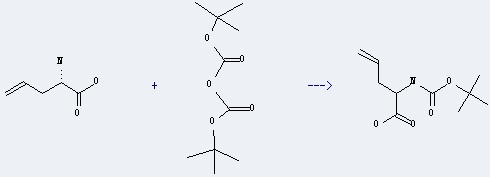-
Name
L-Allylglycine
- EINECS
- CAS No. 16338-48-0
- Article Data18
- CAS DataBase
- Density 1.098 g/cm3
- Solubility soluble in water
- Melting Point 253-255 °C
- Formula C5H9NO2
- Boiling Point 231 °C at 760 mmHg
- Molecular Weight 115.132
- Flash Point 93.5 °C
- Transport Information
- Appearance White to off-white crystalline powder
- Safety 26-36-37/39
- Risk Codes 36/37/38
-
Molecular Structure
-
Hazard Symbols
 Xi
Xi
- Synonyms (2S)-2-aminopent-4-enoic acid;4-Pentenoic acid, 2-amino-, (S)-;(-)-Allylglycine;L-Allylglycine;(S)-2-Amino-4-pentenoic acid;L-alpha-Allyl-Gly;
- PSA 63.32000
- LogP 0.67470
(S)-(-)-2-Amino-4-pentenoic acid Specification
The IUPAC name of (S)-(-)-2-Amino-4-pentenoic acid is (2S)-2-aminopent-4-enoic acid. With the CAS registry number 16338-48-0, it is also named as 4-Pentenoic acid, 2-amino-, (S)-. The product's categories are Pharmaceutical Raw Materials; Amino Acids; Unusual Amino Acids; Chiral Reagent; Chiral Compound; A-amino. Besides, it is white to off-white crystalline powder, which should be sealed in a dry place below 0 °C. In addition, its molecular formula is C5H9NO2 and molecular weight is 115.13.
The other characteristics of this product can be summarized as: (1)ACD/LogP: 0.26; (2)# of Rule of 5 Violations: 0; (3)ACD/LogD (pH 5.5): -2.24; (4)ACD/LogD (pH 7.4): -2.25; (5)ACD/BCF (pH 5.5): 1; (6)ACD/BCF (pH 7.4): 1; (7)ACD/KOC (pH 5.5): 1; (8)ACD/KOC (pH 7.4): 1; (9)#H bond acceptors: 3; (10)#H bond donors: 3; (11)#Freely Rotating Bonds: 4; (12)Index of Refraction: 1.484; (13)Molar Refractivity: 29.99 cm3; (14)Molar Volume: 104.8 cm3; (15)Surface Tension: 42.8 dyne/cm; (16)Density: 1.098 g/cm3; (17)Flash Point: 93.5 °C; (18)Melting point: 253-255 °C; (19)alpha: -37 °(c=4, H2O); (20)Enthalpy of Vaporization: 51.51 kJ/mol; (21)Boiling Point: 231 °C at 760 mmHg; (22)Vapour Pressure: 0.0226 mmHg at 25 °C.
Uses of (S)-(-)-2-Amino-4-pentenoic acid: this chemical is used for inhibition of glutamate decarboxylase. Furthermore, it can react with Di-tert-butyl dicarbonate to get N-tert-Butoxycarbonylallylglycine.

This reaction needs aq. NaOH and Tetrahydrofuran. The yield is 95 %.
When you are using this chemical, please be cautious about it as the following: it is Irritating to eyes, respiratory system and skin. You should wear suitable protective clothing, gloves and eye / face protection when use it. Moreover, in case of contact with eyes, rinse immediately with plenty of water and seek medical advice.
People can use the following data to convert to the molecule structure.
(1)SMILES: O=C(O)[C@@H](N)C\C=C
(2)InChI: InChI=1/C5H9NO2/c1-2-3-4(6)5(7)8/h2,4H,1,3,6H2,(H,7,8)/t4-/m0/s1
(3)InChIKey: WNNNWFKQCKFSDK-BYPYZUCNBS
(4)Std. InChI: InChI=1S/C5H9NO2/c1-2-3-4(6)5(7)8/h2,4H,1,3,6H2,(H,7,8)/t4-/m0/s1
(5)Std. InChIKey: WNNNWFKQCKFSDK-BYPYZUCNSA-N
Related Products
- (S)-(-)-2-Amino-4-pentenoic acid
- 163400-20-2
- 1634-02-2
- 1634-04-4
- 163425-20-5
- 163428-90-8
- 16343-08-1
- 1634-34-0
- 1634-36-2
- 163437-14-7
- 16343-75-2
Hot Products
About|Contact|Cas|Product Name|Molecular|Country|Encyclopedia
Message|New Cas|MSDS|Service|Advertisement|CAS DataBase|Article Data|Manufacturers | Chemical Catalog
©2008 LookChem.com,License: ICP
NO.:Zhejiang16009103
complaints:service@lookchem.com Desktop View